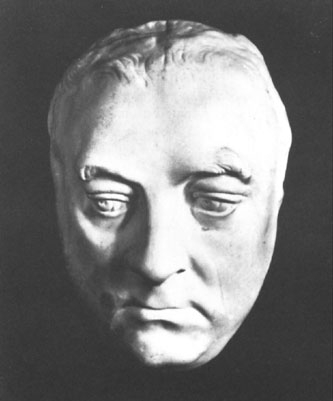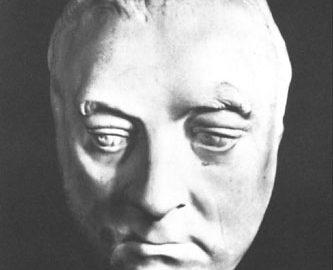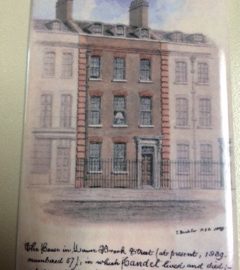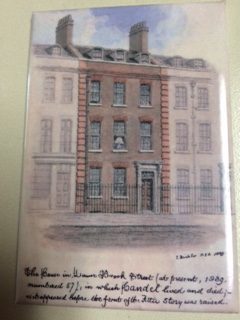Handel blog 10*

From Katherine: There has been much talk of the need for cloth or surgical masks during this pandemic. And we considered the role of the Doctor’s mask during the last of the Plague years in Europe. Our Handel discussion raises the issue of yet another kind of mask. Two hundred sixty-one years ago on this day (April 14, 1759), George Frideric Handel died at his Brook Street home in London. Some biographers claim that a “death mask” was cast of his face and that this mask was used as a model in creating the monument erected in his honor at Westminster Abbey. Others dispute this claim, saying it was instead a “life mask,” one created while he was still alive. Either way, it poses the question of just what such a mask is and how it would have been fashioned from the face of a person, living or dead.
From Clara: I didn’t know there was a “death mask” of Handel, but –and I know you will all find this a bit bizarre—I have followed some blogs that talk about death masks or life masks. I find the idea of recording a person’s features through a cast rather than by photography fascinating. You can see a fun, yes, fun, discussion of the topic here. I think some other famous people have had death masks or life masks. If you watch the YouTube video I mentioned by Caitlin Doughty, you will see how difficult it would be to actually create such a thing, especially a life mask.
From Peter: I found a source that challenges the idea that the “mask” of Handel was made as a cast of his face at all. The author of this article says the supposed mask was more likely made from a sculpted likeness, a statue of Handel made by an artist. You can read his argument here.
From Brad: So, some 260 years ago today was the day our man Handel died. At least he was in his own home. And I suppose his death wasn’t entirely unexpected. Not like Buddy Holly, Richie Valens, and the Big Bopper—wiped out in a plane crash. Still, I guess we could say that for people in Handel’s time, it was sort of “the day the music died,” right?
From Katherine: I suppose so, Brad. Fortunately, Handel’s scores of music survive. But Handel was also an outstanding musician. I imagine those who heard him play the organ or harpsichord would agree that losing Handel the performer was a major loss even though Handel the composer lives on. Creating music has many dimensions. Thanks for joining us on this April 14th—Handel’s death day.
*All posts listed as “Handel blog” are texts that use the fictional characters in my book The Handel Letters: A Biographical Conversation. As in that book, the posts will often reference things from Handel’s life or time period as starting points. And the post will cite a page or paragraph in the book when it seems relevant. Find The Handel Letters.



